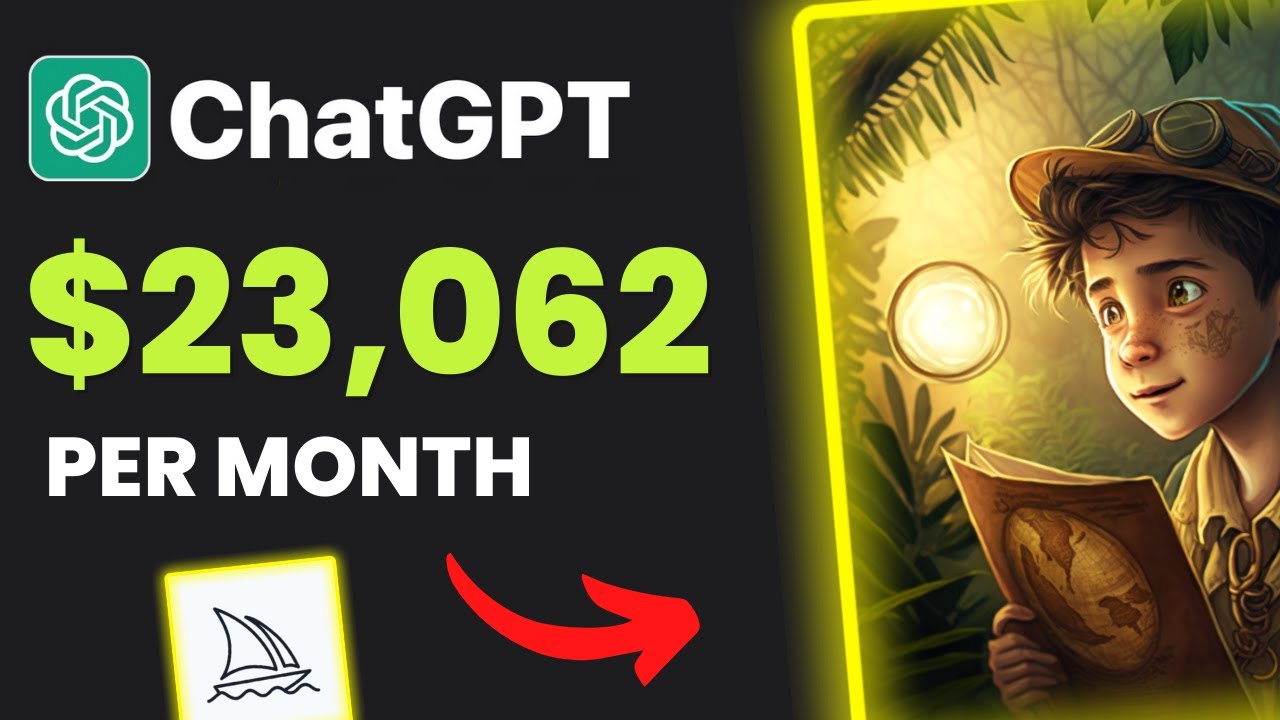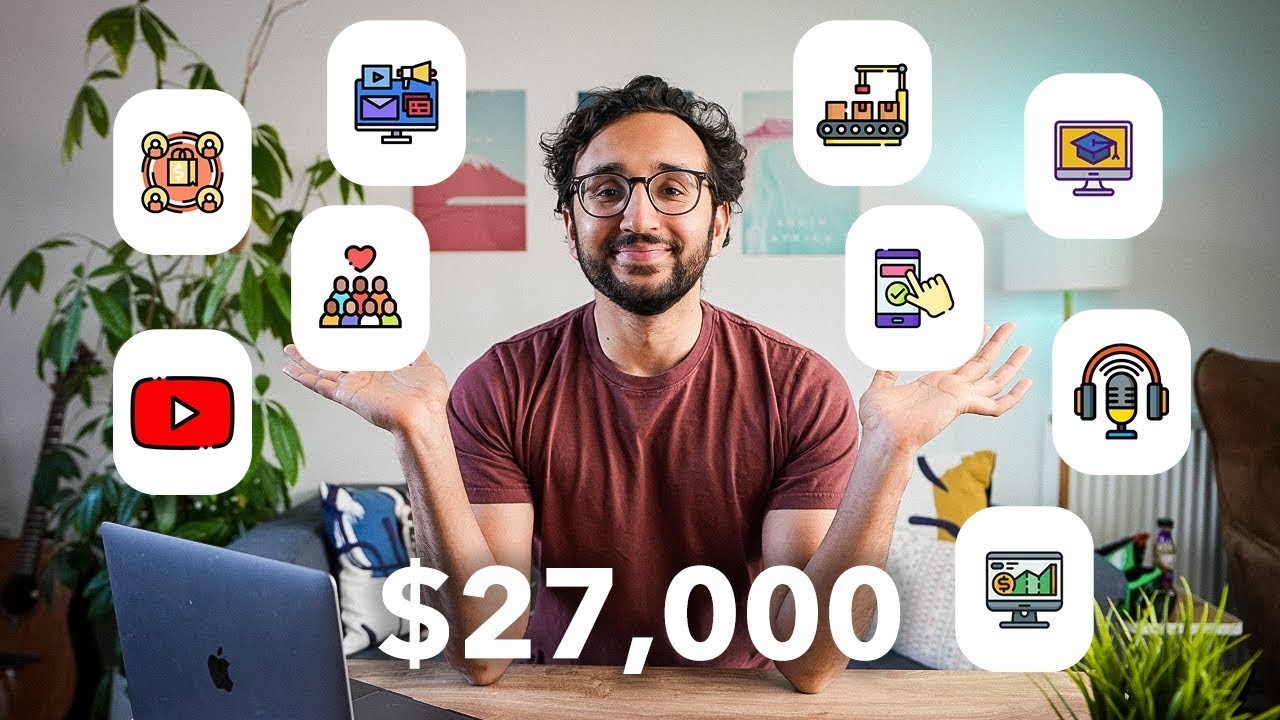In the video by 10X INCOME, you’ll learn how to make passive income with ChatGPT and Midjourney AI. The video walks you through the process of generating a story idea using ChatGPT, creating a story outline and chapters, generating illustrations using Midjourney AI art generator, adding the story text to the images using Canva, and finally publishing the book on Amazon. It provides step-by-step instructions and links to resources for each step, highlighting the ease and speed of using AI technology to create a complete story. The video concludes with a call to action to like, subscribe, and join the creator’s Facebook group for further support and guidance. So if you’re interested in making passive income with AI, this video is a must-watch!
Generating Ideas with ChatGPT
Understanding ChatGPT
ChatGPT is an advanced language model developed by OpenAI that utilizes the power of artificial intelligence (AI) to generate human-like text. It is designed to have interactive and dynamic conversations with users, making it a valuable tool for brainstorming and generating ideas.
By prompting ChatGPT with specific instructions or questions, you can receive creative and diverse responses that can help fuel your imagination and generate unique story ideas or concepts. This makes ChatGPT an excellent resource for writers, authors, and anyone looking for inspiration and creativity in their projects.
Using ChatGPT to brainstorm story ideas
One of the most exciting ways to leverage ChatGPT is to generate story ideas. Whether you’re a writer struggling with writer’s block or someone looking to explore new storytelling avenues, ChatGPT can be a valuable asset in the creative process.
To use ChatGPT effectively for brainstorming story ideas, start by providing it with a prompt related to the genre, theme, or characters you have in mind. For example, you could ask ChatGPT to suggest a story idea for a mystery novel set in a small town.
The AI will then use its vast knowledge base to generate unique and creative suggestions based on the prompt. You can interact with ChatGPT by refining your initial prompt, asking questions, or requesting further details to make the generated ideas more tailored to your needs.
Remember to experiment with different prompts and guide ChatGPT with specific instructions to explore various story possibilities. By leveraging the power of AI, you can unlock new and exciting story ideas that you might not have considered otherwise.
Creating a Story Outline
Importance of a story outline
A story outline serves as a blueprint for your narrative, allowing you to organize your thoughts and structure your story in a coherent and engaging way. It provides a roadmap for your writing process, ensuring that you stay focused and avoid getting lost in the intricacies of your story.
Creating a story outline is crucial for several reasons. It helps you maintain consistency in plot progression, character development, and pacing. It also allows you to identify potential plot holes or inconsistencies early on, enabling you to address them before they become significant issues.
Additionally, a story outline helps you maintain a clear vision of your story’s direction, making it easier to flesh out individual chapters and scenes.
Structuring the outline
When creating a story outline, it’s essential to consider the three-act structure commonly used in storytelling: the setup, confrontation, and resolution. Each act serves a specific purpose in advancing the plot and character development.
In the setup, you introduce your characters, setting, and the central conflict or problem. This act establishes the foundation of your story and hooks the reader, drawing them into your narrative.
The confrontation is where the conflict intensifies, and obstacles emerge, testing your characters’ resolve. It is in this act that you build tension and suspense, keeping readers engaged and invested in your story.
The resolution is the final act, in which the conflict is resolved, and loose ends are tied up. This act provides closure for your readers and brings your story to a satisfying conclusion.
Within each act, divide your story into chapters or scenes, each focusing on specific events, character interactions, or plot developments. This division helps you maintain a cohesive narrative structure and allows for a logical and easily digestible reading experience.
Developing characters and settings
A vital aspect of storytelling is the development of compelling characters and immersive settings. These elements contribute significantly to the overall impact and engagement of your story. When creating your story outline, consider how your characters and settings will evolve throughout the narrative.
Characters should undergo personal growth and transformation as they face challenges and make choices that drive the story forward. Outline their arcs, motivations, and conflicts to ensure consistency and depth in their portrayal.
Settings play a crucial role in establishing the tone, atmosphere, and believability of your story. Outline the key locations and environments where your story takes place, describing them in enough detail to immerse your readers in the world you’ve created.
By focusing on character and setting development in your story outline, you lay the groundwork for a rich and captivating narrative that readers can connect with on an emotional level.

This image is property of i.ytimg.com.
Writing Story Chapters
Crafting engaging beginnings
The beginning of your story sets the tone and grabs the reader’s attention, making it essential to craft an engaging and captivating start. Here are some tips to consider when writing the opening chapters of your story:
-
Start with a hook: Begin with an intriguing event, question, or conflict that compels the reader to continue reading. This can be a dramatic event or an introduction to an intriguing character or setting.
-
Establish the setting and introduce the main characters: Provide vivid descriptions of the story’s world and introduce the main characters early on. The reader should have a clear understanding of the setting and a sense of connection with the characters from the start.
-
Create intrigue and curiosity: Pose questions or mysteries that pique the reader’s curiosity and make them want to uncover more. This can be a foreshadowing of future events or a hint at something unusual or mysterious happening.
-
Set the tone and establish the genre: Use language, descriptions, and narrative style to set the tone and atmosphere of your story. This helps readers understand the genre and what they can expect from the rest of the narrative.
Remember, the beginning of your story is your chance to make a lasting impression, so take the time to craft an opening that captivates and engages your readers from the very first pages.
Developing the plot and conflict
A well-developed plot is the backbone of any compelling story. It drives the narrative forward and keeps readers invested in the outcome. Here are some strategies for developing a strong plot:
-
Create a central conflict: Your story should have a central conflict or problem that the main characters must overcome. This conflict should be clearly defined and create tension and obstacles for the characters throughout the story.
-
Build rising action: As the story progresses, introduce new challenges, complications, and surprises for the characters to face. This helps to maintain momentum and keeps readers engaged.
-
Use pacing effectively: Vary the pace of your story to create moments of tension, suspense, and action. Balancing fast-paced scenes with slower, reflective moments can create a dynamic reading experience.
-
Develop subplots: Subplots can add depth and complexity to your story. They can involve secondary characters or explore different aspects of the main plot. Be sure to weave subplots seamlessly into the main narrative to avoid confusion.
By carefully crafting your plot and conflict, you can create a narrative that keeps readers on the edge of their seats, eagerly turning pages to discover what happens next.
Creating suspense and excitement
Suspense and excitement are essential elements in keeping readers engaged and invested in your story. Here are some techniques to create suspense and excitement in your story chapters:
-
Cliffhangers: End chapters with unresolved conflicts or unanswered questions to create a sense of anticipation for the next chapter. This encourages readers to continue reading to find out what happens next.
-
Foreshadowing: Drop subtle hints or clues about future events to create a sense of anticipation and intrigue. Foreshadowing can heighten suspense and keep readers guessing.
-
Unpredictability: Surprise your readers by introducing unexpected plot twists, character revelations, or shocking events. This unpredictability adds excitement and keeps readers engaged.
-
Time pressure: Employ a sense of urgency by incorporating time limits or deadlines into your story. This can create tension and heighten the stakes for the characters.
By incorporating these techniques into your storytelling, you can create a narrative that keeps readers on the edge of their seats, eagerly anticipating the next twist or turn.
Generating Illustrations with Midjourney AI
Introduction to Midjourney AI art generator
Midjourney AI is an innovative platform that utilizes artificial intelligence to generate high-quality illustrations. It enables users to bring their stories to life with stunning visuals, all without the need for expensive artists or extensive design skills.
The AI art generator offered by Midjourney AI is powered by state-of-the-art algorithms, which can create realistic and diverse images based on specific prompts or descriptions. This makes it a valuable tool for authors and storytellers who want to enhance their narrative with visually appealing illustrations.
Choosing the appropriate style and theme
When using Midjourney AI to generate illustrations, it’s essential to consider the style and theme that best align with your story. The platform offers a wide range of artistic styles, from realistic to cartoonish, allowing you to choose the aesthetic that complements your narrative.
Consider the tone, genre, and target audience of your story when selecting the style and theme for your illustrations. Matching the visual elements with the overall vibe of your story can create a cohesive reading experience and enhance the reader’s immersion.
Additionally, ensure that the generated illustrations accurately represent the characters, settings, and key scenes from your story. This will help readers visualize the story elements and deepen their engagement with the narrative.
Generating high-quality illustrations
With Midjourney AI, generating illustrations for your story is a simple and efficient process. To get started, sign up for an account on Midjourney AI’s platform and access their AI art generator.
Once you have access to the AI art generator, you can input specific prompts or descriptions to guide the AI in generating suitable illustrations. For example, you can describe a specific scene or request an illustration of a particular character in a specific pose or environment.
After the AI art generator processes the information and generates the initial illustration, you can further refine and customize the image to meet your specific requirements. This may include adjusting colors, adding details, or refining the overall artistic style.
By leveraging the power of Midjourney AI’s art generator, you can access high-quality illustrations that enrich your story and create a visually captivating experience for your readers.
This image is property of images.unsplash.com.
Adding Text to Images with Canva
Importance of visual storytelling
Visual storytelling is a powerful technique that combines text and images to create a compelling and immersive reading experience. By integrating text with relevant and visually appealing images, you can enhance the impact of your story, engage readers on a deeper level, and convey information more effectively.
Visual storytelling allows you to communicate emotions, atmosphere, and key story elements in a concise and engaging manner. It helps create a strong connection between readers and your narrative, making it easier for them to follow the story and understand complex concepts.
Using Canva for text and image integration
Canva is a user-friendly online design platform that provides a wide range of tools and templates for creating visually appealing content. It offers a simple drag-and-drop interface and a variety of customization options, making it an ideal choice for integrating text with images.
To use Canva for text and image integration, follow these steps:
-
Sign up for a Canva account and log in to the platform.
-
Search for “Storybook” templates or browse the available options to find a suitable template for your project.
-
Once you’ve selected a template, upload the AI-generated illustrations from Midjourney AI to Canva. This can be done by dragging and dropping the image files into the template or by using the upload feature within Canva.
-
Position the images within the template to create visually appealing layouts. Resize or crop the images as necessary to fit the desired format.
-
Add text boxes to the template and fill them with the text generated by ChatGPT. You can customize the font, size, color, and alignment of the text to enhance readability and visual appeal.
-
Arrange the text and images in a way that balances the visual elements and creates a harmonious composition. Consider the hierarchy of information and ensure that the text and images flow cohesively.
-
Experiment with different layouts, font styles, and color schemes to find the combination that best suits your story and visual aesthetic.
Formatting and creating visually appealing pages
To make your storybook visually appealing and engaging, pay attention to the formatting and presentation of each page. Here are some tips to create visually appealing pages using Canva:
-
Consistency: Maintain a consistent layout and design elements throughout the storybook. This helps create a cohesive visual experience and enhances readability.
-
White space: Use white space effectively to create breathing room and draw attention to essential elements. A balanced composition with proper spacing ensures that the reader’s focus is on the text and images.
-
Typography: Choose fonts that are easy to read and complement the overall design. Consider using different font sizes or styles for headings, titles, and body text to create visual variety.
-
Color palette: Select a color palette that aligns with the tone and theme of your story. Use colors strategically to evoke emotions or create visual interest. Ensure that the colors of the text and images harmonize well together.
-
Visual hierarchy: Arrange text and images in a way that directs the reader’s attention and creates a clear visual hierarchy. Highlight important information or key elements by using contrasting colors, sizing, or positioning.
By paying attention to these formatting and design elements, you can create visually stunning pages that enhance the reading experience and bring your story to life.
Publishing on Amazon
Overview of the self-publishing process
Publishing your story on Amazon gives you the opportunity to reach a vast audience and potentially generate passive income. Here is an overview of the self-publishing process on Amazon:
-
Create an Amazon Kindle Direct Publishing (KDP) account: Sign up for a free KDP account on the Amazon KDP website.
-
Format your manuscript: Prepare your story manuscript according to Amazon’s formatting guidelines. This includes properly formatting the text, organizing chapters, and ensuring that the document is error-free.
-
Design a captivating book cover: Create an eye-catching book cover that reflects the genre, tone, and theme of your story. You can hire a professional cover designer or use design software like Canva to create your cover.
-
Set the book details: Enter essential book details, such as the title, author name, book description, and keywords. These details help potential readers discover your book when searching on Amazon.
-
Set the pricing and royalty options: Determine the price of your ebook and select the royalty option that best suits your preferences. Amazon offers different royalty rates based on factors like the price of your book and whether you enroll in the Kindle Unlimited program.
-
Upload your manuscript and cover: Use the KDP dashboard to upload your formatted manuscript and book cover. Preview your book to ensure that it looks good on various devices.
-
Review and publish your book: Once you’re satisfied with the appearance of your ebook, review the publishing options and click on the “Publish” button. Your book will then be available for purchase on Amazon.
Preparing the book for publication
Before publishing your book on Amazon, there are a few essential steps you should take to ensure its quality and professionalism:
-
Proofread and edit: Review your manuscript multiple times for spelling errors, grammatical mistakes, and inconsistencies in the storyline. Consider hiring a professional editor if you want an extra layer of assurance.
-
Beta readers and feedback: Share your story with a group of beta readers who can provide feedback and suggestions. Their insights can help you identify areas for improvement and ensure that your story resonates with readers.
-
Professional formatting: Follow Amazon’s formatting guidelines and ensure that your ebook is properly formatted to provide a seamless reading experience on various devices.
-
Cover design: Invest in an appealing and professional book cover that captures the essence of your story. A well-designed cover can significantly impact your book’s visibility and reader appeal.
By meticulously preparing your book for publication, you increase your chances of attracting readers, receiving positive reviews, and achieving success in the competitive market.
Marketing strategies for increased visibility
Publishing your book on Amazon is just the beginning. To increase its visibility and attract readers, you need to implement effective marketing strategies. Here are a few tactics to consider:
-
Establish an author website or blog: Create a website or blog dedicated to your writing and your book. Share updates, behind-the-scenes content, and engage with your readers to build a community around your work.
-
Social media presence: Leverage social media platforms to promote your book. Create accounts on platforms like Instagram, Twitter, and Facebook, and share engaging content related to your writing journey and your book. Interact with your audience and join writing and reading communities to expand your reach.
-
Book reviews and endorsements: Request honest reviews from readers and reach out to influencers or book bloggers for endorsements. Positive reviews and endorsements can significantly impact potential readers’ decision to choose your book.
-
Engage with your readers: Host virtual author events, Q&A sessions, or giveaways to engage with your readers and build a devoted fan base. Encourage readers to leave reviews and provide feedback, as this can help generate buzz and attract new readers.
-
Leverage book promotions: Take advantage of Amazon’s promotional tools, such as Kindle Countdown Deals, Kindle Free Book Promotions, or Amazon Advertising, to boost your book’s visibility and attract new readers.
Remember that marketing is an ongoing process, and it takes time to build an audience. Stay persistent, utilize various marketing channels, and continuously refine your strategies based on reader feedback and market trends.

This image is property of images.unsplash.com.
STEP-BY-STEP INSTRUCTIONS
Detailed instructions for each stage of the process
-
Generating story ideas with ChatGPT:
- Access the ChatGPT platform or interface.
- Prompt ChatGPT with a specific instruction or question related to your desired story idea.
- Refine the prompt or ask follow-up questions to receive more tailored and creative suggestions.
- Experiment with different prompts and instructions to explore various story possibilities.
- Take notes on the generated ideas and select the most promising ones to move forward.
-
Creating a story outline:
- Divide your story into three acts: setup, confrontation, and resolution.
- Outline the main events, conflicts, and character arcs for each act.
- Break down each act into chapters or scenes, specifying the key events and character interactions.
- Ensure consistency in plot progression, character development, and pacing throughout the outline.
- Review and refine the outline as needed before proceeding to the next stage.
-
Writing story chapters:
- Craft an engaging beginning that hooks the reader and introduces the main characters and setting.
- Develop the plot and conflict by introducing obstacles, challenges, and twists.
- Create suspense and excitement through cliffhangers, foreshadowing, and unpredictable plot developments.
- Maintain a balanced pacing and rhythm, alternating between fast-paced scenes and slower, reflective moments.
- Pay attention to character development, ensuring that the main characters undergo growth and transformation.
-
Generating illustrations with Midjourney AI:
- Sign up for an account on Midjourney AI’s platform.
- Access the AI art generator and start a prompt.
- Describe the specific illustrations you need based on your story’s chapters, characters, or scenes.
- Select the artistic style and theme that best align with your story.
- Customize and refine the generated illustrations to meet your specific requirements.
- Save the illustrations to your device for later use.
-
Adding text to images with Canva:
- Create a Canva account and log in to the platform.
- Search for “Storybook” templates or select a suitable template for your project.
- Upload the AI-generated illustrations from Midjourney AI to Canva.
- Drag and drop the images into the template, positioning them as desired.
- Add text boxes to the template and input the text generated by ChatGPT.
- Customize the text by adjusting the font, size, color, and alignment.
- Ensure a balanced composition and a cohesive visual flow throughout each page.
-
Publishing on Amazon:
- Create an Amazon Kindle Direct Publishing (KDP) account.
- Format your manuscript according to Amazon’s guidelines.
- Design a captivating book cover that reflects your story’s genre and theme.
- Set the book details, including title, author name, description, and keywords.
- Determine the pricing and royalty options based on your preferences.
- Upload your formatted manuscript and cover through the KDP dashboard.
- Review and preview your ebook to ensure its appearance and functionality.
- Publish your book on Amazon and make it available for purchase.
-
Marketing strategies for increased visibility:
- Establish an author website or blog to share updates and engage with readers.
- Leverage social media platforms to promote your book and connect with potential readers.
- Request book reviews from readers and seek endorsements from influencers or book bloggers.
- Host virtual author events or giveaways to engage with your audience and build a community.
- Take advantage of Amazon’s promotional tools and advertising options to boost visibility.
- Continuously refine your marketing strategies based on reader feedback and market trends.
RESOURCES FOR EACH STEP
Helpful links and tools for generating ideas
- OpenAI: Official website of OpenAI, the organization behind ChatGPT.
- ChatGPT: Access the ChatGPT platform for generating story ideas.
- AI Story Prompts: Provides AI-generated story prompts to spark creativity.
Free and paid resources for creating illustrations
- Midjourney AI: Official website of Midjourney AI, an AI art generator platform.
- IllustrationX: Online platform for hiring professional illustrators.
- Canva: Online design platform offering free and paid illustration and graphic design tools.
Useful templates for Canva
- Canva Templates: A wide range of pre-designed templates for various purposes, including storybooks.
Tips and tricks for successful self-publishing
- Amazon KDP: Official website of Amazon Kindle Direct Publishing with resources and guidelines for self-publishing authors.
- Kindlepreneur: A comprehensive resource for self-publishing authors, offering tips and strategies for success.
- The Creative Penn: A blog and podcast focused on self-publishing and marketing for authors.
By utilizing the resources and tools provided, you can streamline your creative process, harness the power of AI, and take advantage of self-publishing opportunities.

This image is property of images.unsplash.com.
EMPHASIZING THE EASE AND SPEED OF AI
Highlighting the advantages of using AI technology
One of the primary advantages of using AI technology, such as ChatGPT and Midjourney AI, is the ease and speed at which creators can generate ideas and create visually appealing content. AI models like ChatGPT can provide quick and diverse responses, effortlessly generating story ideas or answering specific prompts.
Additionally, AI art generators like Midjourney AI can save creators significant time and expense by generating high-quality illustrations that would otherwise require hiring professional artists. This accessibility empowers individuals with limited resources or artistic skills to bring their creative ideas to life.
Showcasing how AI streamlines the creative process
Integrating AI technology into the creative process streamlines and enhances various stages, making it an invaluable tool for storytellers, writers, and artists.
ChatGPT accelerates the brainstorming process, providing a constant stream of creative and unique ideas. With AI-generated story outlines and chapter content, writers can save time and focus on refining the narrative rather than starting from scratch.
Midjourney AI’s art generator significantly simplifies the process of creating illustrations, enabling creators to visualize their stories without the need for extensive artistic skills or expensive professional artists. This automation frees up time and resources, allowing creators to focus on other aspects of their projects.
Benefits of automation and efficiency
By leveraging the power of AI, creators can benefit from increased automation and efficiency throughout their creative endeavors.
The ease of generating ideas with ChatGPT and creating illustrations with Midjourney AI allows creators to spend more time perfecting their stories and enhancing the reading experience. It eliminates the need for manual brainstorming or drawing, streamlining the process from ideation to publication.
AI technology also reduces barriers to entry in the storytelling world. With the ability to generate ideas, create illustrations, and self-publish, creators can bring their stories to life quickly and independently. This democratization of the creative process empowers writers, artists, and storytellers of all backgrounds to pursue their passions and reach audiences on a global scale.
CONCLUSION
Summarizing the benefits of making passive income with ChatGPT and Midjourney AI
The combination of ChatGPT and Midjourney AI offers creators a powerful and efficient way to generate ideas, develop engaging stories, create visually stunning illustrations, and publish their work on platforms like Amazon.
The ease of brainstorming story ideas with ChatGPT allows writers to unlock hidden creativity and explore new narrative possibilities. The efficient process of creating story outlines, chapters, and character development sets a solid foundation for captivating storytelling.
With Midjourney AI’s art generator, creators can quickly generate professional-quality illustrations that bring their stories to life. This eliminates the need for costly and time-consuming manual art creation, making it accessible to creators of all levels of artistic expertise.
By leveraging the efficiency and automation provided by AI technology, creators can save time, energy, and resources throughout the creative process, ultimately maximizing their potential for success.
Inspiring readers to take action and explore the opportunities
If you are a writer or storyteller looking to turn your ideas into passive income opportunities, the combination of AI tools like ChatGPT and Midjourney AI opens up a world of possibilities. By using these tools, you can overcome creative blocks, create engaging stories, and transform them into professionally illustrated books.
Embrace the convenience and speed offered by AI technology to unlock your creative potential and make your mark in the publishing industry. Start generating ideas, outlining your stories, and exploring the vibrant world of self-publishing. With dedication, persistence, and the power of AI, you too can embark on a rewarding journey of passive income and creative fulfillment.





